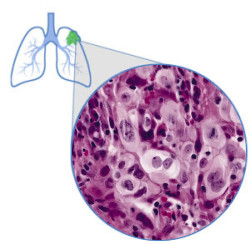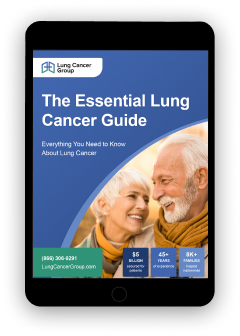Large Cell Carcinoma
Large cell carcinoma is a rare type of non-small cell lung cancer typically caused by smoking, but also exposure to other toxic materials like asbestos. Patients usually live for 3 years, but you could have even more time with the right treatment plan. Get help for large cell carcinoma from our team right now.
What Is Large Cell Carcinoma?
 Large cell carcinoma is one of the types of non-small cell lung cancer (NSCLC). It’s the rarest type of lung cancer, according to the Lung Cancer Foundation of America, but if you’re diagnosed, there are treatments that can help you potentially live longer.
Large cell carcinoma is one of the types of non-small cell lung cancer (NSCLC). It’s the rarest type of lung cancer, according to the Lung Cancer Foundation of America, but if you’re diagnosed, there are treatments that can help you potentially live longer.
Quick Facts About Large Cell Carcinoma
- Large cell carcinoma makes up around 10% of all lung cancer diagnoses.
- It’s also known as large cell lung cancer, according to the LUNGevity Foundation.
- The average life expectancy for large cell lung cancer is 35 months or around 3 years, with some patients becoming long-term survivors.
If you or someone you love has been diagnosed with large cell carcinoma or another type of lung cancer, we can help you find treatments to potentially improve your survival time and pursue compensation to cover any medical expenses.
Get our Free Lung Cancer Guide to explore all of the resources you may qualify for.

- Understand risk factors
- Find top treatments
- Pursue compensation



What Causes Large Cell Carcinoma Tumors?
Like other lung cancers, large cell carcinoma tumors can develop if you were exposed to carcinogens (cancer-causing agents) like smoke or asbestos fibers.
- Smoking cigarettes: This remains the biggest cause of large cell carcinomas and other types of NSCLC.
- Asbestos: Breathing or swallowing asbestos fibers can cause large cell carcinoma 10-50 years later. You’re at a high risk if you worked with or around asbestos at jobs like construction and shipbuilding.
- Radon: This is an odorless and invisible gas that can build up in lower levels of houses or basements.
- Secondhand smoke: Even if you didn’t smoke, you could get sick from breathing in tobacco smoke.
- Other toxic materials: Arsenic, air pollution, and diesel exhaust can all lead to large cell carcinoma or other types of NSCLC.
Being exposed to more than one of these possible causes increases your risk. For example, you’re more likely to develop large cell carcinoma or any other type of lung cancer if you smoked and were exposed to asbestos.
Large Cell Carcinoma Symptoms
Symptoms of large cell carcinoma are very similar to those of the other lung cancer types with some of the most common signs being a cough and difficulty breathing.
Common large cell lung cancer symptoms include:
- Appetite loss
- Bone pain
- Coughing up rust-colored mucus or blood
- Chest pain
- Fatigue
- Hoarse voice
However, you may not have any large cell carcinoma lung cancer symptoms at first. This is because symptoms typically only appear after the cancer has started to spread through your body.
Diagnosing Large Cell Carcinoma
You’ll need to get a couple of different tests if you or your doctor is concerned that you have large cell carcinoma or another type of lung cancer. The first step in diagnosing lung cancer is to get a basic exam.
Note any symptoms and history of smoking or asbestos exposure during this time. From there, your doctor can recommend imaging tests to look inside your body for signs of large cell carcinoma.
Imaging tests used to diagnose large cell carcinoma may include:
- Bronchoscopy, a procedure that lets doctors look at your air passages and lungs by inserting a tube through your mouth or nose
- Chest X-rays, which can show doctors whether you have tumors or suspicious growths in your lungs
- Computed tomography (CT) scans, which combine a series of X-rays to get a better look at your lungs
- Magnetic resonance imaging (MRI) scans, which use computer-generated radio waves and a magnetic field to see inside your lungs and chest


Doctors may determine you have large cell carcinoma if the lung cancer cells don’t look like one of the other types of NSCLC (such as squamous cell lung cancer or adenocarcinomas).
Diagnosed with large cell carcinoma? Call (877) 446-5767 now for information on top treatments and affording expenses.
Large Cell Carcinoma Misdiagnosis
Sometimes, large cell carcinoma can be misdiagnosed despite the best efforts of doctors. A common reason for misdiagnosis is that many patients only have mild symptoms at first.
Large cell carcinoma may be misdiagnosed as:
- Acid reflux
- Asthma
- Chronic obstructive pulmonary disease (COPD)
- Gastroesophageal reflux disease (GERD)
- Inflammatory myofibroblastic tumors
- Lung nodules
- Lymphoma
- Pulmonary embolism
- Tuberculosis
A misdiagnosis can prevent you from receiving treatment on time. If you believe your large cell carcinoma has been misdiagnosed, get a second opinion from a cancer expert.
Types of Large Cell Carcinoma
Your doctor may diagnose you with a specific type of large cell carcinoma. It’s important to know which type you have because some are easier to treat than others.
Types of large cell carcinoma include:
- Basaloid carcinoma
- Clear cell carcinoma
- Large cell neuroendocrine carcinoma (LCNEC)
- Combined LCNEC
- Giant cell carcinoma
- Lymphoepithelioma-like carcinoma
- Rhaboid large cell carcinoma
Your doctor can give you a better idea of what to expect if you have any of these specific types of large cell carcinoma at the time of diagnosis. Many of these types are rare, but your doctors will do all they can to treat you and improve your survival time.
Large Cell Lung Carcinoma Prognosis
The general lung cancer prognosis, or health outlook, is 3 years after a large cell carcinoma diagnosis. However, factors such as your general health, the size of the tumor, and more all affect your prognosis.
Doctors typically measure the prognosis for large cell carcinoma using figures known as survival rate and life expectancy. Learn about each below.
Large Cell Lung Carcinoma Life Expectancy
Life expectancy is the amount of time doctors think you’ll live after a large cell carcinoma diagnosis. The overall life expectancy for large cell carcinoma was 35 months as noted by Translational Lung Cancer Research.
You could live longer if your large cell lung cancer is diagnosed in an earlier stage, when it’s easier to treat. Lower stages mean the cancer hasn’t spread, so it can more easily be destroyed with treatment.
Here are large cell lung carcinoma life expectancy statistics by stage:
- Stage 1: 42 months
- Stage 2: 22 months
- Stage 3: 11 months
- Stage 4: 3 months
Still, long-term survival could be possible even if you have late-stage large cell carcinoma.
A stage 4 patient lived for 2 years cancer-free despite metastasis (spread) to the brain, thanks to chemotherapy and radiation, according to Drug Design, Development and Therapy.
What is the Survival Rate for Large Cell Carcinoma?
Survival rate is the percentage of patients who are still living a certain number of years after being diagnosed with lung cancer or another type of illness.
Survival rates for large cell carcinoma include:
- 1-year survival rate: 40%
- 3-year survival rate: 21%
- 5-year survival rate: 15.6%
It could be possible to live even longer in some cases, depending on how your cancer tumors respond to treatment, if you were diagnosed in an early stage, and more.
Large Cell Carcinoma Treatment Options
There are several lung cancer treatments for large cell carcinoma patients, such as surgery, chemotherapy, and clinical trials.
Which treatment is the best choice for you or a loved one depends on various factors. These factors include the stage of the cancer, your age, medical history, and whether cancer metastasis has occurred.
Surgery
Surgery may be an option if you were diagnosed with early-stage large cell carcinoma. Doctors can perform lung cancer surgery to remove visible tumors. Part or all of the lung nearest to the tumors may also be taken out to prevent the cancer from coming back.
Chemotherapy
Chemotherapy uses drugs that kill fast-growing cells like large cell carcinoma lung tumors. You may receive chemotherapy alongside surgery for early-stage large cell carcinoma, or it could be the main type of treatment in advanced stages.
Radiation Therapy
Your health care provider may use radiation therapy if the large cell carcinoma has grown too large to remove through surgery. Radiation damages the DNA of lung cancer cells, causing the tumors to shrink.
Targeted Cell Therapy
Targeted therapy allows doctors to kill large cell lung carcinoma cells while doing less harm to healthy tissues and organs. Targeted therapy for lung cancer may be used as part of a larger care plan with other treatments.
Immunotherapy
Immunotherapy drugs stimulate your immune system to fight lung cancer. There are many types of immunotherapies that could be used to treat large cell carcinoma, including cancer vaccines, tumor-infecting viruses, and checkpoint inhibitors.
Get our Free Lung Cancer Guide to find out more about treatments that could help you live longer after a large cell carcinoma diagnosis.



- Understand risk factors
- Find top treatments
- Pursue compensation



Get Help for Large Cell Carcinoma
Receiving a large cell carcinoma diagnosis can bring a lot of uncertainty, from knowing which treatments will work best for you to how you’ll afford the medical care you need.
Lung Cancer Group is ready to stand by you after a large cell lung carcinoma diagnosis, allowing you to get the support you deserve.
Our team may be able to help you:
- Find top doctors and treatments for your case
- Pursue financial compensation for expenses
- Access other resources to assist you and your family
Get our Free Lung Cancer Guide or call (877) 446-5767 to learn more about how we can assist you or someone you love with large cell carcinoma.
Large Cell Carcinoma FAQs
What's the difference between small cell cancer and large cell cancer?
When it comes to large cell carcinoma vs small cell carcinoma, also known as small cell lung cancer (SCLC), there are several key differences.
SCLC is a rare and fast-growing type of lung cancer. It’s more common than large cell carcinoma, accounting for up to 34,000 lung cancer diagnoses per year. SCLC is typically harder to treat than large cell carcinoma.
Who is at risk of large cell carcinoma?
You’re at a high risk of large cell carcinoma and other types of lung cancer if you are a current or former smoker. Smoking cigarettes remains the biggest overall cause of all types of lung cancer.
You also could develop large cell lung carcinoma if you were exposed to other cancer-causing materials like asbestos or radon, or have a family history of cancer.
Is large-cell neuroendocrine carcinoma NSCLC?
Yes, large-cell neuroendocrine carcinoma (LCNEC) is considered a type of non-small cell lung cancer (NSCLC). LCNEC makes up around 20% of lung cancer diagnoses, according to The Journal of Clinical Medicine.
Treatment is available if you or someone you love has been diagnosed with LCNEC or another form of NSCLC. Call (877) 446-5767 now to learn more.
Is large cell carcinoma curable?
There’s not a one-size-fits-all cure for large cell lung carcinoma. With that said, doctors may consider you “cured” if treatment sends your cancer into remission for a long period of time.
You have a better chance of being considered cured of large cell carcinoma if you’re diagnosed in an early stage. The cancer won’t have spread past the lungs, meaning doctors can effectively treat it.
Is large cell carcinoma rare?
Yes, large cell carcinoma is rare. In fact, it’s considered one of the rarest types of lung cancer. It accounts for just 1 in 10 overall lung cancer diagnoses.
Even though large cell carcinoma is rare, doctors can still recommend treatment options that may help you or someone you love live longer.
Can large cell carcinoma go into remission?
Yes, large cell carcinoma can go into remission. This is when there are no or fewer signs of cancer in your body. It’s more likely for your lung cancer to go into remission if you’re diagnosed at an early stage and receive aggressive treatments.
Get a Free Lung Cancer Guide to learn about treatments that could help your cancer go into remission.

